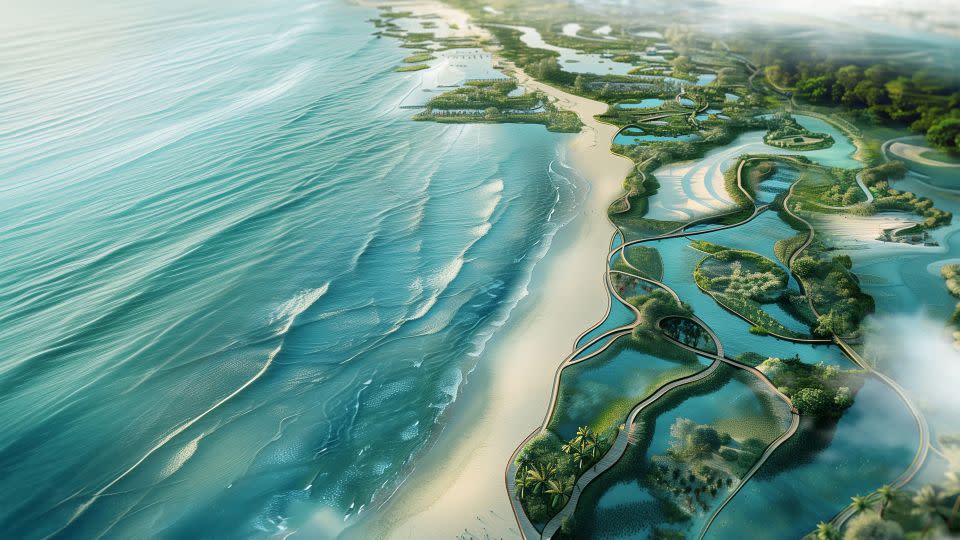Plans for ‘world’s largest coastal regeneration project’ revealed in Dubai
Editor’s Note: This CNN series is, or was, sponsored by the country it highlights. CNN retains full editorial control over subject matter, reporting and frequency of the articles and videos within the sponsorship, in compliance with our policy.
A stretch of more than 70 kilometers (43 miles) of shoreline in Dubai could become the site of the “world’s largest coastal regeneration project,” if a project called Dubai Mangroves were to go ahead.
Over 100 million mangroves — a group of trees and shrubs that live mainly in coastal waters, where they are able to support entire ecosystems — would be planted as part of the project. That’s enough to absorb over 1.2 million metric tons of CO2 per year, according to URB, the sustainable city developer behind the initiative — the equivalent of removing 260,000 gas-powered vehicles from the road.
“Mangroves are nature’s own defense system against coastal erosion and rising sea levels, which are crucial concerns for any coastal city, including Dubai,” says Baharash Bagherian, an urban planner and founder of URB.
“Currently, we’re in the research phase,” he adds. “We have identified six locations for proposed pilot studies as next stages and are focusing on the designs for those locations. We envision the project’s completion by 2040.”
Better than a rainforest
URB’s other designs, which are all still in the planning phase, include a masterplan to equip Dubai with over 1,000 kilometers (621 miles) of cycling lanes by 2040, and Dubai Reefs, a floating community for marine research and ecotourism that would include the world’s largest artificial reef.
Dubai Mangroves was originally proposed as part of Dubai Reefs, and later singled out as a separate initiative. According to Bagherian, it’s meant to address several environmental and urban challenges. “Primarily, it aims to combat the effects of climate change,” he says, which is achieved via the mangroves’ natural ability to mitigate sea level rise — by gradually creating a buffer between sea and land — and their ability remove carbon dioxide directly from the atmosphere.
Mangroves are able to do this 10 times faster than mature tropical forests and they can then store the carbon three to five times more densely, according to the US National Atmospheric and Oceanic Administration.
They bring other benefits, too, as they act as nurseries for marine life and create a natural habitat for fish, birds and other plants, increasing biodiversity. They also directly improve the economy of coastal communities by supporting fisheries and aquaculture, as well as providing raw materials for crafts and construction.
Finally, as demonstrated by other mangrove hotspots around the world, they can become a tourist attraction. “The project is set to raise the bar for ecologically responsible tourism, by creating an environment where visitors can enjoy nature without harming it,” Bagherian says, adding that the goal is not only to attract tourists but to encourage them to become active participants in preserving the natural heritage.
A conservation center staffed by marine biologists and a large botanical museum are among the facilities planned for the visitor hub.

AI gardeners
Technology will play a role in both the development and the operations of Dubai Mangroves, with artificial intelligence (AI) constantly checking over the plants. “We are looking at utilizing cutting-edge tools such as drone reforestation to plant mangroves efficiently and remote sensing technology to monitor the health and growth of the mangrove forests,” says Bagherian.
Drones would precisely place the mangrove seeds in locations where they have the best chance of survival. Satellite imagery would then be used to gain an overview of the mangrove coverage, making it easier to identify areas that require increased attention. At the same time, AI-driven analytics could process large chunks of data to offer guidance to biologists and urbanists on restoration efforts and policy decisions.
Six areas are currently being considered for pilot studies that would inform the final plan for the project: Jebel Ali Beach, Dubai Marina Beach, Jumeirah Public Beach, Umm Suqeim Beach, Mercato Beach and Dubai Islands Beach.
Bagherian believes that as well as tackling climate change and boosting the local economy through ecotourism, the project would improve quality of life for locals.
“On a social level, it enhances urban liveability by offering recreational spaces for residents and visitors, improving air quality, and contributing to the mental and physical well-being of the community,” he says.
For more CNN news and newsletters create an account at CNN.com

